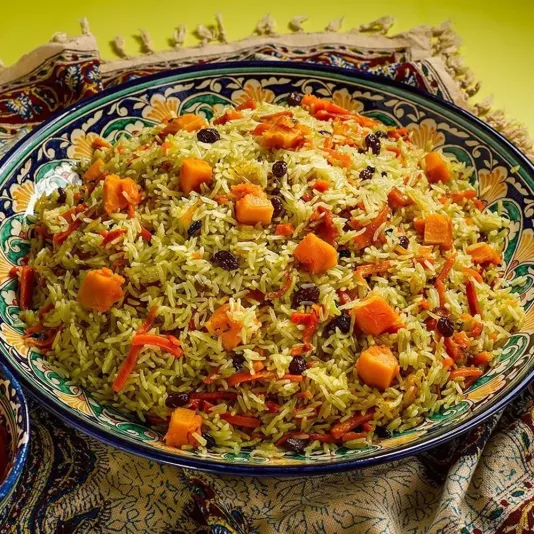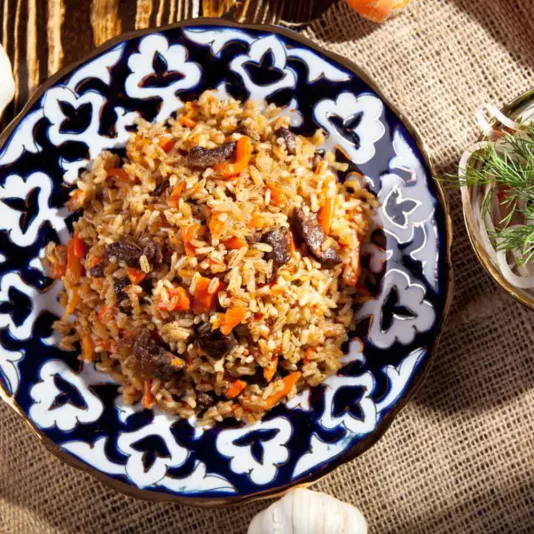Uzbek Cuisine
Uzbek cuisine is a combination of tradition, generosity, and deep understanding of the product. Every dish conveys care for taste and respect for the process. Over the years, I’ve learned that Uzbek dishes do not tolerate haste: pilaf needs time for the rice to absorb the aroma of spices, samsa – for the dough to rest, and lagman – for the flavors to blend. It’s important not only to follow the recipe but also to feel the rhythm of cooking. The meat is fried to golden brown, vegetables are stewed slowly, spices are added gradually to release their strength. This cuisine teaches patience and mindfulness: even a simple dish turns into something special when it’s made with soul. Uzbek cuisine doesn’t just feed – it brings people together at the same table, filling the home with the aroma of warmth and hospitality.
Recipes of Uzbek Cuisine
Uzbek recipes are an example of culinary harmony between tradition and practicality. Over the years of cooking, I’ve realized that the main secret of success lies in respect for the product and precision in details. For pilaf, not only rice and meat are important, but also the frying time of the carrot: if you rush, the dish will lose its depth of flavor. In samsa, everything depends on the baking temperature of 220°C (428°F) and the dough’s moisture. For lagman, I always use homemade noodles because store-bought ones can’t withstand long stewing. Uzbek dishes require patience – there’s no place for quick decisions. You should let the meat soak in its own juice, the vegetables reach tenderness, and the spices unfold. That’s why I consider Uzbek cuisine a true school of attentiveness. Its recipes don’t tolerate haste but reward generously with deep flavor and homely comfort.
Pilaf – The Heart of Uzbek Cuisine
For me, pilaf is not just a dish but the embodiment of Uzbek cuisine. I’ve learned that true pilaf is born only when every stage is done precisely. The meat should be fried to a rich color, the onion softened but not burnt, and the carrot must retain its shape. The frying temperature is crucial: too high heat will dry it out, too low will make the taste flat. The rice should be rinsed until the water runs clear; otherwise, the dish will become sticky. I always use cumin, barberry, and a bit of garlic – they add depth. The key is not to stir the pilaf until it’s fully cooked so that the rice remains fluffy. After removing it from the heat, I always let it sit covered for 15-20 minutes so the aroma saturates every grain. This simple ritual makes the flavor harmonious and the texture perfect. That’s how I make pilaf I’ve been proud of for many years.
Samsa – the Delicate Art of Dough and Filling
Samsa is one of those dishes where small details determine the result. In my practice, the main thing is to prepare the dough correctly: it should be elastic but not sticky. I roll it in layers, brush with melted butter, and let it cool so that characteristic layers appear during baking. The filling is made from finely chopped meat, onion, and spices. It’s important not to grind the ingredients in a meat grinder – this preserves the juiciness. Bake samsa in a well-preheated oven at 220°C (428°F) so the crust immediately seals and keeps the juice inside. If the temperature is lower, the dough becomes hard, and the filling dries out. I always brush the top of samsa with egg yolk and sprinkle sesame seeds – it’s not just for beauty but also for aroma. After baking, I let it rest a little so the steam doesn’t ruin the texture. Samsa is a test of skill I always embrace with joy.
Lagman – The Harmony of Noodles, Meat, and Vegetables
When I cook lagman, I always remember my first attempts to make the right noodles. They must not only be rolled out but also “pulled” by hand, feeling the elasticity of the dough. If it’s too firm, it will tear; if too soft, it won’t hold shape. For the sauce, I use lamb, pepper, tomatoes, garlic, and a bit of cumin. I fry the vegetables one by one so each keeps its flavor. Then I combine everything and stew until thick, when the sauce coats the noodles. The key in lagman is balance: too many vegetables will overshadow the meat, and a lack of spices will make it bland. I’ve learned not to rush – to let the dish rest after cooking so the flavors blend. Uzbek lagman is the harmony of homely comfort, patience, and respect for ingredients. It taught me that cooking is not only a technique but also a sense of proportion.
Tandoor Baking – the Aroma of an Uzbek Home
The brightest memory of Uzbek cuisine for me has always been the aroma of freshly baked flatbreads from the tandoor. It’s not just bread – it’s a symbol of home. I’ve experimented a lot to achieve the right balance of flour, salt, and water. The dough must be firm, well-kneaded, and rest for at least an hour to develop gluten. Bake the flatbreads at a high temperature of 250°C (482°F) in the oven or on a stone if there’s no tandoor. Before baking, I brush the surface with water and sprinkle sesame seeds – this makes the crust crispy. If you skip this step, the bread will be dry. I wrap the ready flatbreads in a towel to keep them soft. They pair perfectly with pilaf, shurpa, or simply tea. Uzbek baking teaches simplicity and gratitude: even with three ingredients, you can create warmth that fills the entire home.
Secrets of Spices and Flavor Balance in Uzbek Dishes
Spices in Uzbek cuisine are not just aroma but the language of flavor. Over the years, I’ve learned to sense exactly how much cumin, coriander, or barberry each dish needs. An excess of spices makes the flavor heavy, and their absence – colorless. In pilaf, I add spices gradually to control the aroma. In shurpa – a bit more, because the broth needs depth. The main thing is not to mix everything at once: each spice has its moment. For example, cumin should be rubbed between the palms before adding to release essential oils. Turmeric adds color but easily overpowers flavor, so I use it carefully. Another secret is ingredient quality: old spices lose their strength, so I store them in glass jars away from light. The right combination of spices turns any Uzbek dish into true pleasure.





